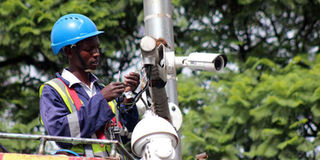Integrated security system a remedy

A CCTV camera under repair on Kenyatta Avenue, Nairobi, on February 22, 2017. The CCTV layout was seen as a panacea to crime and yet the city is still facing serious security challenges. PHOTO | DENNIS ONSONGO | NATION MEDIA GROUP
What you need to know:
- For an effective security system, you need an integration of both the technical and human capacity.
- In a well-planned urban area, houses are numbered and the county planning department has automated data.
Nairobi rolled out three years ago a modern CCTV system aimed at reducing crime.
The CCTV layout was seen as a panacea to crime and yet the city is still facing serious security challenges.
Many companies and businesses, especially hotels and shopping malls have installed state-of-the-art security gadgets such as bollards, CCTV; walk-through metal detectors and even deployed sniffer dogs.
INTEGRATION
What many of us don’t know is that these fall short of an integrated security system or management.
These are stand-alone security installations. For an effective security system, you need an integration of both the technical and human capacity.
An Integrated Security System must address three vital components, and if one is ignored, it almost becomes ineffective.
First, you need both security and non-security components.
HUMAN RESOURCE
The security components will further focus on the technical and human capacity.
Technical security must involve the coordination of various components such as electronic access control system, barriers, perimeter protection, intrusion detection systems, CCTV, biometrics and effective service support.
The human capacity will include motivated law enforcement persons (the police) well-trained, well-remunerated and well-vetted guards.
The non-security components will focus on the auxiliary components that enhance integrated security indirectly.
MOBILE
Certain information from citizens indirectly assists security and investigations.
With almost all adults linked to mobile money transfers and their personal data with mobile service providers, there is no way security agents can divorce themselves from any corporation with mobile security providers.
Equally, the security organs need an element of direct connectivity to other government agencies such as the National Transport and Safety Authority (NTSA) for easy access to vehicle registrations numbers and owners’ details.
While the NTSA is venturing into the automatic number plates recognition system, it must be coordinated with the National Police Service and insurance providers.
COMMUNICATION
One may argue that it will be a challenge to achieve an integrated security system, considering our working culture where sibling rivalry is common.
This can be overcome by setting agreed authorisation profiles for the relevant departments, including the police, NTSA, KRA and county governments.
To avoid the challenge of interoperability, where systems cannot communicate, a joint secretariat can be formed for the departments to know what the right and the left hands are doing.
URBAN PLANNING
When the county government is upgrading its lighting system, there will be a need to have persons from the corporate world who have specialised in security lighting give guidance on the streetlight specifications to have an effective system for CCTV recordings.
Where we have frequent blackouts, we must look for a lighting system that will have a quick restrike time if power is lost.
This means that we must avoid high-pressure sodium lighting and metal halide lamps that have a slow restrike time.
The other key component of an integrated security system will be the general urban planning of the city.
DATA
This is currently a serious challenge to our urban areas where over half of the population live in slums.
The major security deficit here is the unreliable data of the residents.
In a well-planned urban area, houses are numbered and the county planning department has automated data.
Through the integrated security system, the law enforcement agencies can access data very fast to know who the dwellers in some specified areas are.
AUTOMATION
With automated data, the work of the police becomes much easier.
The same automation can be extended to motor vehicle insurance and driving licences.
Today, our police depend on manual identification of insurance defaulters and it is believed many motor vehicles are on the road with fake insurance.
An effective integrated security system comes with many auxiliary benefits other than the intended enhanced security.
BENEFITS
It creates employment for the highly educated youth on ICT, it reduces bureaucracy, which is a big nuisance in the public service, and overall, it creates confidence in the public and other players such as the business community.
An integrated security system makes investigations easy, fast and less stressful. It is also a good deterrence to crime.
Mr Mbarak is a retired military officer and a certified security management professional. [email protected]





